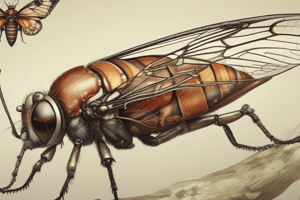Podcast
Questions and Answers
Match the following parts of the content with their corresponding topics:
Match the following parts of the content with their corresponding topics:
Physical features of Insects = Introduction to Insects' Body Where do insects live and what do they eat? = Insects' Habitat and Diet Habits and Behaviour = Insects' Way of Living Life cycle of Insects = Insects' Stages of Development
Match the following sections of the content with their corresponding purposes:
Match the following sections of the content with their corresponding purposes:
Aim and Objectives = Outlining the goals of the unit Introduction = Introducing the topic of insects End of unit = Concluding the unit on insects Ladybug Says… = Providing a fun insect-related message
Match the following types of insects with their corresponding traits:
Match the following types of insects with their corresponding traits:
Ladybug = Helpful to the environment Caterpillar = Undergoing metamorphosis Butterfly = Has a complex life cycle Ant = Lives in colonies
Match the following image credits with their corresponding sources:
Match the following image credits with their corresponding sources:
Match the following concepts with their corresponding topics in the unit:
Match the following concepts with their corresponding topics in the unit:
Flashcards are hidden until you start studying
Study Notes
Aim and Objectives
- Establish a clear understanding of insect biology and behavior.
- Explore the ecological roles insects play, both beneficial and harmful.
Introduction
- Insects are a diverse group of organisms essential to ecosystems.
Physical Features of Insects
- Insects possess three main body parts: head, thorax, and abdomen.
- They have an exoskeleton made of chitin, which provides support and protection.
- Most insects have six legs, compound eyes, and one pair of antennae.
Where Do Insects Live and What Do They Eat?
- Insects inhabit various environments, including forests, deserts, and aquatic systems.
- Their diets vary widely; some are herbivores, while others are carnivores or detritivores.
Life Cycle of Insects
- Insects undergo metamorphosis, typically involving stages: egg, larva, pupa, and adult.
- The life cycle can vary significantly among species, with some having complete metamorphosis while others have incomplete.
Habits and Behaviour
- Insects display diverse behaviors, including social structures in species like ants and bees.
- Communication methods include chemical signals (pheromones) and sounds.
Insects That Are Harmful and Helpful to the Environment
- Some insects, like bees and butterflies, are critical for pollination, supporting plant reproduction.
- Others, like mosquitoes and locusts, can transmit diseases or damage crops.
End of Unit
- Summary includes insights into insect biology and their ecological significance.
- Emphasizes the dual nature of insects as both beneficial and harmful organisms.
Studying That Suits You
Use AI to generate personalized quizzes and flashcards to suit your learning preferences.




